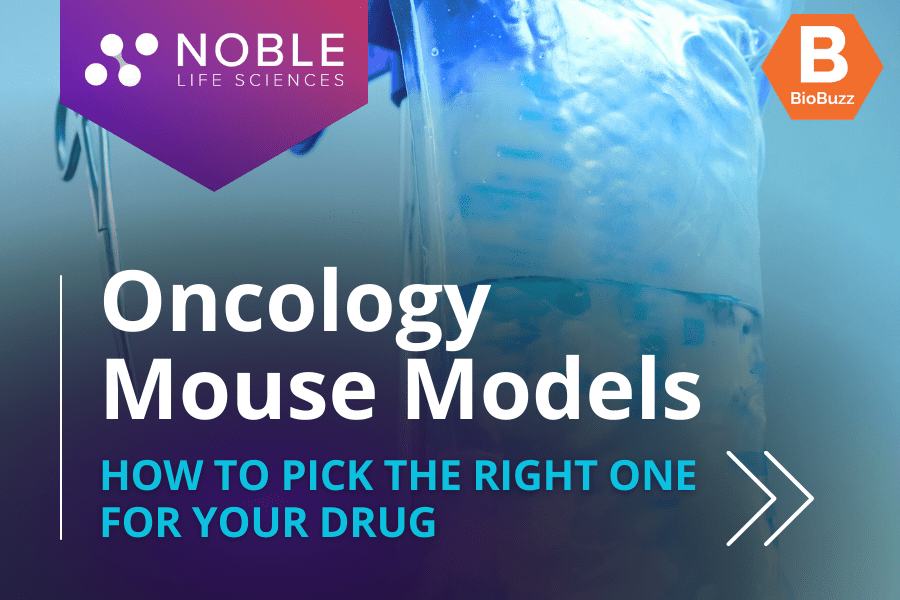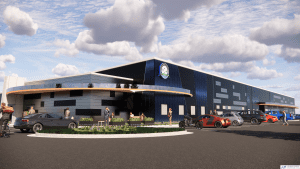
Oncology Mouse Models: How to Pick the Right Mouse Model for Your Oncology Drug Development Needs?
Mouse models have long been used in oncology drug development. With improved technology, they have become even more sophisticated, able to provide answers to numerous scientific questions during the development timeline. Here is some insight on selecting the right oncology mouse model for your needs.
By Mark Terry | October 13, 2023
Brought to you by Noble Life Sciences
| BioBuzz is thrilled to welcome guest posts and contributing writers to the “hive.” Enjoy the read from one of our expert contributors and be sure to get in touch if you have an idea or perspective you’d like to share. We’d love to buzz about it to see if it’s a fit! |
The use of appropriate mouse models in oncology drug discovery is a crucial step in target identification and validation, as well as toxicity and efficacy evaluations. In many cases, contract research organizations (CROs) handle preclinical animal work for biopharma companies due to the need for specific facilities and expertise. There are a range of available oncology mouse models for researchers that are appropriate for specific types of testing. Selecting the best oncology mouse models for your program offers a greater chance of success, while also managing costs and timelines.
Selecting a mouse model during the drug discovery process takes a multifactorial approach. There are usually numerous scientific questions being asked during cancer drug development, which often requires a variety of mouse models.
Types of Oncology Models
Broadly, there are two types of oncology mouse models: xenograft models, or human tumors in mice, and syngeneic models, or mouse tumors in a mouse with a matched immune system. Each one of these tumors can either be implanted under the skin (subcutaneous) or in the tissue the tumor was derived from (i.e., lung tumors in lung tissue) referred to as orthotopic.
Subcutaneous Xenograft
Subcutaneous xenograft models are when human tumors or cancer cells are implanted under the skin of an immunodeficient mouse or rat. These can either be from well-established cancer cell lines or directly from patients (PDX or patient-derived xenograft).
Advantages include:
- Simple and quick to use. Xenograft mouse models are easier to implant and monitor compared to orthotopic models, which may need specialized surgical techniques and imaging.
- Readily available. Tumor measurements can typically be taken using calipers, and do not require specialized imaging systems or biomarker assays.
- less expensive than orthotopic mouse models.
Orthotopic Xenograft
Orthotopic mouse models involve implanting cancer cells into the same organ or tissue from which it originated in humans.
Advantages include:
- Tumor microenvironment. Because the tumor microenvironment may play a role in tumor growth and response to the drug, these types of mouse models better recapitulate the native tumor microenvironment.
- Tumor metastasis. Orthotopic models are believed to more closely replicate metastasis of human tumors compared to subcutaneous xenografts.
The use of PDX models either as subcutaneous or as orthotopic models provides additional diversity of tumor type and can better model tumor microenvironment interactions.1
Syngeneic
Murine cancer cells are implanted in genetically matched mouse strains are referred to as syngeneic. A collection of mouse cell lines are available that have been established from mouse tumors from a variety of tissues including liver, colon, breast, lung, pancreas, and blood, providing broad biology and a variety of orthotopic sites to study. Syngeneic mouse models are often used for studying tumor immunity and immunotherapy response in the context of a fully functional murine immune system. They are particularly useful in studying novel immuno-oncology and metastasis targeting agents.
GEMMs (genetically modified mouse model)
Used for in-depth study of mechanisms of action for defined protein targets and oncogenic mechanisms. GEMMs can recapitulate the genetic background and tumor environment better than other models but present challenges with large variations in tumor burden and long timelines for tumor growth.
Humanized Mouse Model
These mouse models provide some attractive characteristics of both xenograft and syngeneic models. Mice that have no endogenous murine immune system can be transplanted with human immune cells and/or tissue transplants; they are highly immunodeficient mice, so they do not reject xenografts or transplants. These are excellent models for studying the human immune system’s interaction with human tumor cells and are particularly informative when testing therapeutics that only react with human proteins like checkpoint inhibitor antibodies.
Selecting the Right Mouse Model
As mentioned above, selecting an oncology mouse model requires a multifaceted approach. It is likely that a single model will only provide partial information. As a result, it’s important that the scientific objectives or questions being asked are clearly identified to best determine the model or models that are most appropriate.
Broadly, the type of research determines the best model2. For example:
Adapted from Subczuk et al.2
| Type of Research | 1st Choice | 2nd Choice |
| Role of genetic alterations | GEM | |
| Role of carcinogens | Chemically-induced models | Syngeneic models; GEMs |
| Role of microenvironment | Syngeneic: GEM, CDX | Humanized model; PDX |
| Role of immune system | Syngeneic; GEM | Humanized model; PDX |
| Mechanisms of distant metastases | CDX; Syngeneic model | GEM |
| Testing new drugs | Syngeneic; GEM; PDX; CDX; humanized-induced models | PDX; CDX; chemically-induced models |
Other considerations include logistical factors, such as cost, availability, and required expertise. For example: A syngeneic tumor study that uses 30 mice and
will receive subcutaneous injections of a tumor cell line with simple tumor growth measurements will have a much lower price point than studies with immunodeficient mice and orthotopic tumors measured using imaging. Cost considerations can determine the type of model you use and how you design your experiments. Mouse tumor models that require specialized mice, imaging, irradiation, slow-growing tumors, or molecular monitoring will have higher prices and longer study duration which will affect both budget and timelines.
Experienced CROs will work with you to help design an effective study that meets both animal welfare requirements and your study goals.
Challenges
Mouse models have been used in cancer research for decades and have contributed significantly to drug development in cancer, but much work is left to do. As Carmen Phillips noted in a National Cancer Institute blog3,4, “Developing mouse models that provide meaningful research results — namely, by ensuring they replicate how cancer behaves in humans as closely as possible — has been a high priority for the research community.”
Advances in animal models of cancer continue at a rapid pace with the introduction of PDX models to represent human tumor genetics more accurately, induced genetic mutations in mice to study early tumorigenesis and progression, and humanized mouse models to effectively test immuno-oncology agents. These cutting edge tools are now available to better test new therapeutic agents.
Jeffrey Chuang, Ph.D., of the Jackson Laboratory for Genomic Medicine, told the NCI blog, “To get to the clinical stage is such a big investment, so you want the best data possible” to make the decision to move research from preclinical stages to clinical stages.
In the same NCI blog post, Senthil Muthuswamy, Ph.D., of Beth Israel Deaconess Medical Center and Harvard Medical School, who develops research models of cancer noted, “No model is perfect. Just because a model is not a perfect reflection of human tumors, that doesn’t mean it’s not useful.”
Conclusion
When moving an oncology compound through preclinical development, a large range of oncology mouse models are now available to be utilized. Whether you require a specific type of human tumor expressing your target, a model with an active immune system, or a specialized orthotopic implantation to study your tissue of interest, you can now access a multitude of resources to test the right model for your therapy. Each system has its advantages and disadvantages, and by working closely with experts, you can select the most appropriate models to meet your drug development needs. Working closely with your CRO to consider the specific scientific questions you’re trying to answer while evaluating factors such as cost, timelines, and schedules can lead to productive results.
To find out more about oncology mouse models, contact a representative of Noble Life Sciences, a leading preclinical Contract Research Organization specializing in oncology drug development today.
Sources
1. Long JE, Jankovic M, Maddolo D. Drug discovery oncology in a mouse: concepts, models and limitations. Future Science. 23 Jun 2021;7(8). https://www.future-science.com/doi/10.2144/fsoa-2021-0019
2. Sobczuk P et al. Choosing the Right Animal Model for Renal Cancer Research. Translational Oncology. 2020;13(3):100745. https://www.sciencedirect.com/science/article/pii/S1936523319306394?via%3Dihub
3. Phillips C. PDX Mouse Models Are Reliable Stand-Ins for Human Tumors, Study Finds. National Cancer Institute. February 2, 2021. https://www.cancer.gov/news-events/cancer-currents-blog/2021/cancer-pdx-mouse-models-retain-genetics-human-tumor
4. Woo XY et al. Conservation of copy number profiles during engraftment and passaging of patient-derived cancer xenografts. Nat Genet. 2021 Jan;53(1):86-99. https://pubmed.ncbi.nlm.nih.gov/33414553/
- About the Author
- Latest Posts
Mark Terry is a freelance writer, editor, novelist and ghostwriter. He holds a degree in microbiology & public health and spent 18 years in infectious disease research and clinical and research genetics prior to his transition to a writing career. His areas of expertise include biotechnology, pharma, clinical diagnostics, and medical practice management. He has written literally thousands of articles, as well as market research reports, white papers, more than 20 books, and many other written materials. He currently lives in Michigan with his family.







